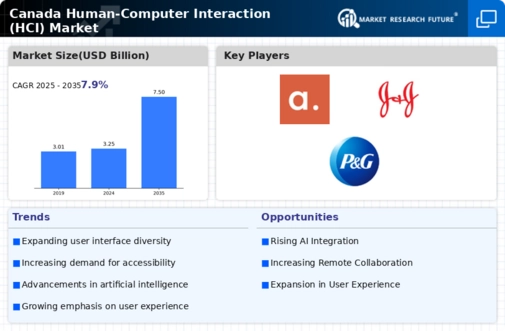The Canada Human-Computer Interaction (HCI) market is undergoing substantial transitions as a result of technological breakthroughs and changing customer behavior. The increasing integration of artificial intelligence into HCI systems, which improves user experience through personalization and efficiency, is a key industry driver. The Canadian government encourages technological innovation by funding research and development in HCI, hence creating a favorable climate for both start-ups and established enterprises to innovate and personalize products to Canadian users.
Recent trends show an increase in remote work and e-learning, driving demand for intuitive and accessible user interfaces. This trend has resulted in a focus on building platforms that cater to various populations, such as older persons and people with impairments, in order to ensure technological inclusion. Furthermore, the Canadian population is growing more technologically adept, raising consumers' expectations for flawless software and hardware interactions. Opportunities exist to produce localized content and applications that resonate with varied Canadian cultures and languages, leveraging the population's multilingualism.
There is also significant interest in HCI solutions for healthcare, where better patient interfaces can improve care quality.HCI innovators in Canada are encouraged to prioritize sustainability in design, which aligns with government goals promoting environmental responsibility. The confluence of these elements encourages continued investment and interest in developing effective HCI solutions targeted to Canadians while addressing local regional concerns and embracing technological improvements.
Canada Human-Computer Interaction (HCI) Market Drivers
Growing Demand for Advanced User Interfaces
In Canada, the demand for more sophisticated user interfaces is significantly driving the Human-Computer Interaction (HCI) market. As organizations, such as the Canadian government, push for the digital transformation of public services, there has been a marked increase in the need for intuitive and user-friendly interfaces. According to data from the Government of Canada, over 90% of Canadians accessed government services online in 2021, demonstrating a clear shift toward digital solutions.This trend indicates a strong demand for HCI systems that can enhance user experience and facilitate easier interactions with technology.
The development of mobile applications, artificial intelligence interfaces, and virtual assistants requires robust HCI solutions that adapt to user needs, thus propelling market growth. By 2025, an anticipated increase in the adoption of e-government services is expected to further solidify the role of HCI in improving public engagement and service delivery.
Increase in Remote Work and Digital Collaboration Tools
The COVID-19 pandemic has resulted in a paradigm shift towards remote work in Canada, which is a prominent driver for the Human-Computer Interaction (HCI) market. Statistics Canada reported that in 2020, approximately 32% of employed Canadians worked from home. This remote work trend has heightened the demand for digital collaboration tools that facilitate seamless interaction among remote teams.
Companies like Shopify, a leading Canadian e-commerce platform, have embraced this shift, enhancing their HCI systems to support a better user experience in virtual environments.As businesses increasingly move towards flexible working models, the necessity for improved human-computer interactions will spur market growth, with organizations investing in tools that foster effective communication and collaboration among remote teams.
Rising Significance of User-Centric Design
The implementation of user-centric design principles is essential for the evolution of the Canada Human-Computer Interaction (HCI) market. There is a growing recognition of the importance of user experience (UX) design in enhancing product usability. Elements like ease of navigation, accessibility, and user satisfaction are paramount, especially as organizations across various sectors prioritize customer engagement.
The Canadian Digital Service has emphasized user-centric design practices, leading to better engagement rates in public service platforms.Additionally, studies have shown that investing in user experience can yield a return on investment of up to 100% for digital services. This focus on designing products that are directly aligned with user needs is likely to continue driving significant growth within the HCI market.
Canada Human-Computer Interaction (HCI) Market














Leave a Comment